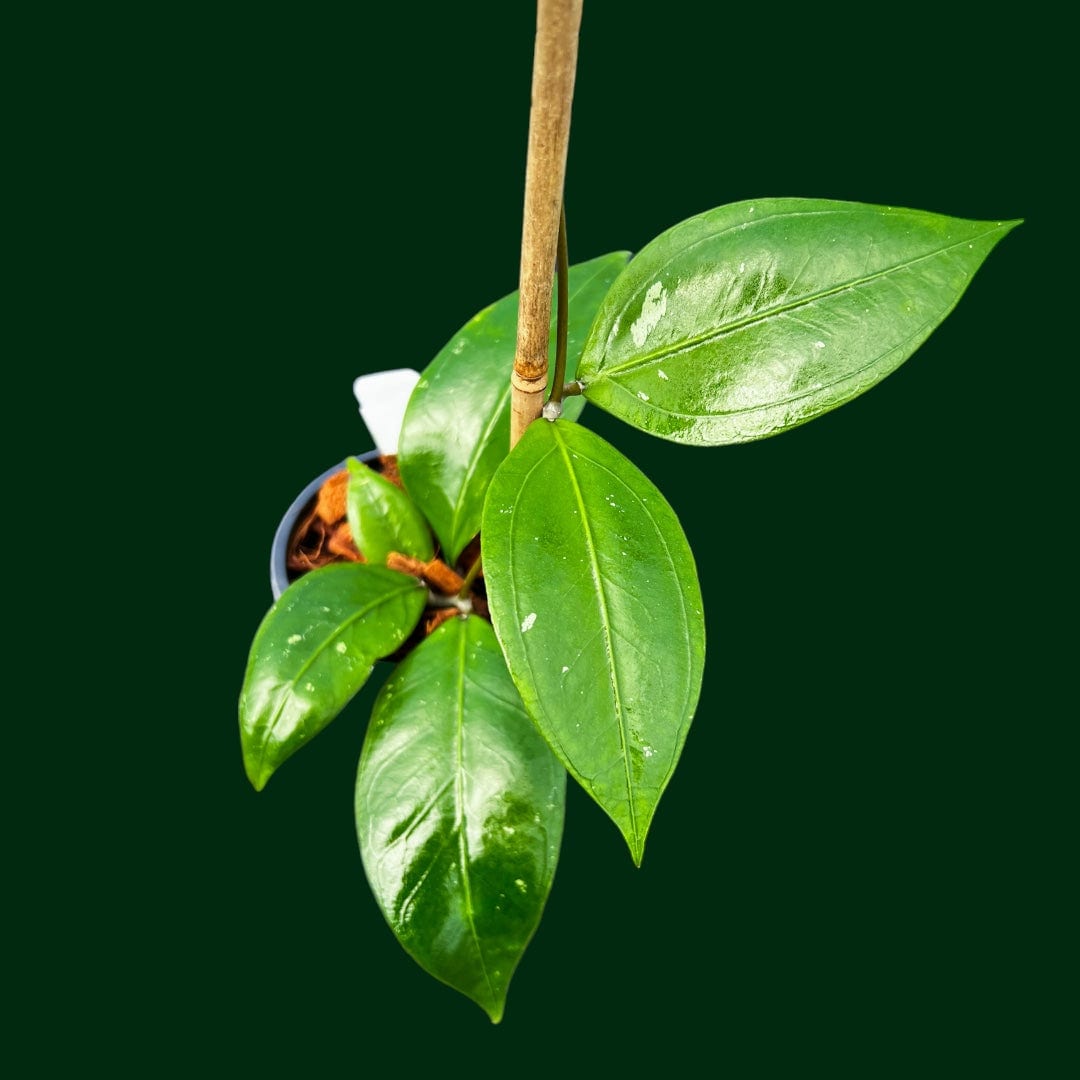Watering Houseplants: How Often and How Much?

Table of Contents
- Tip #1: Consider the Type of Plant, and its Water Needs
- Tip #2: Let the Soil Dry
- Tip #3: Water Deeply
- Tip #4: Water Plants According to the Environment
- Tip #5: Use Quality Water for Houseplants
- Tip #6: Adjust Watering During Different Seasons
- Signs of Overwatering
- Wrapping Up
Houseplants are a wonderful way to bring nature into our homes. They can purify the air, improve our mood, and add a pop of beautiful color to any room.
However, if you're new to caring for your green friends, you might find yourself wondering how much to water houseplants, how often, and the best way to water them (hint: using tap water is not a good idea!).
In this Brown Thumb Therapy post, I'll help you learn how to water effectively, and explore some watering tips for indoor plants. That way, you will feel more confident in your plant care abilities (and maybe I'll even inspire you to add a hoya to your plant collection!)
Tip #1: Consider the Type of Plant, and its Water Needs

The first step in watering houseplants is understanding their individual needs. Many houseplants will do well with water every 1 or 2 weeks, but don't treat all your plants equally.
Different types of plants depend on different watering schedules, so it's important to research your specific plant to determine how much to water it and how often.
The best way to start is to look at the plant's native climate. For example, succulents and cacti are native to dry climates, so they are plants that prefer to be watered infrequently and in small amounts. Others, like ferns and aroids, thrive in climates where it rains frequently, so they'll be moisture-loving plants.
Also, consider the age of your plant. Younger plants, propagations, and cuttings will need more frequent watering to help roots to grow. Established plants will not need as much care.
Researching your plant's specific watering needs will help you avoid over-watering or under-watering, which can be detrimental to the plant's health.
Tip #2: Let the Soil Dry

The best way to determine whether your plant needs water is by checking the moisture level of the soil (or other substrate - coco husk is our favorite). Don't be fooled if the soil is dry on top. Instead, stick your finger into the soil up to the second knuckle. If the soil feels dry at this depth, it's time to water the plant.
If you feel wet soil, you don't need to water just yet; wait a few more days before checking again. Plants like moisture, but too much can lead to fungal infections, rotting roots systems, and other plant diseases, so it's better to err on the side of underwatering than overwatering.
PRO TIP: Container plants can have different needs, depending on the type of pot they are placed in. Terra cotta pots, for example, are highly porous and will draw water away from soil more quickly, which can affect how often your waterings take place. Make sure your pots have at least one drainage hole, with a saucer underneath, to protect your furniture in case of over-watering.
Tip #3: Water Deeply

When it's time to water your plant, make sure to water it thoroughly, so that moisture can reach the roots at every point, without excess water logging the soil (or other substrate). If you only wait for the soil surface to get moist, you might risk underwatering your plant.
Water the plant until the water runs out the bottom of the pot. This helps prevent salt buildup in the soil. Let the soil drain until there is no more dripping, and then place the saucer back underneath the pot.
Plants also like bottom watering, which is a process where you place pots in a tray or bowl filled with water, and let it absorb from the base of the plant. Don't leave your plants for more than 30 minutes, and let the water drain thoroughly before putting pots back in their homes.
If your plant is in a pot without drainage holes, we suggest replacing it (or, place the plant in a plastic pot with a drainage hole, and use the other pot as a cover). If you can't replace or repot, be sure to water it with care. Roots don't like to sit in water most of the time, so try to avoid water buildup and root rot.
Tip #4: Water Plants According to the Environment

The environment in which your plant lives can also affect its watering needs. If your plant is in a window that gets a lot of direct sun exposure or in a room with low humidity, it may need to be watered more frequently than a plant in a cooler, more humid room.
Time of day can also be impacting your plants, though this is more true for watering your garden or potted plants outside. Water in the morning is absorbed by plants before the hottest part of the day, but evening or night watering may be better in very hot climates outside.
Similarly, if your plant is in a pot that's too small for its root system, it may need to be watered more frequently to ensure it's getting enough water. However, we'll recommend that you always water plants in appropriately sized pots, to prevent any root system problems.
Tip #5: Use Quality Water for Houseplants

The type of water you use for your plants can also affect their health. If you get the water from your tap, (even softened water) it may contain chlorine, fluoride, and other chemicals that can be harmful to plants' roots or foliage.
So, how do you know what water to use?
Rather than tap water, it's best to use water that has been distilled when possible.
Distilled water will also allow you to control the nutrients in your water, it's pH, and help you give your plants the nutrition they need.
Tip #6: Adjust Watering During Different Seasons

Finally, it's important to adjust your watering routine depending on the season. In the summer months, when temperatures are higher and humidity is lower, your plants may need to be watered more frequently.
In the winter months, when temperatures are cooler and humidity is higher, your plants may need to be watered less frequently. Pay attention to your plant's soil moisture and adjust your watering schedule accordingly.
Signs of Overwatering

One of the most common mistakes people make when caring for indoor plants is overwatering. When plants get too much water, it can cause significant damage to roots, foliage, and more. Knowing the signs of overwatering can help you address the problem before it's too late.
-
Yellowing leaves

Yellowing leaves are a common sign of over-watering in houseplants. Too much water causes the roots to become waterlogged, and the plant can't absorb nutrients properly. This leads to a lack of chlorophyll in the leaves, which causes them to turn yellow. If you notice yellowing leaves, it's crucial to water less often.
-
Soft, mushy leaves

Soft, mushy leaves can be another sign that you need to wait for dry soil, even a couple inches into your pot. When leaves absorb too much water, they become too soft, and in some cases can begin to rot. If you notice leaves that are softer than usual, your plants need more time to dry.
-
Mold or mildew

When you water more often, it can create a perfect environment for mold and mildew to grow. If you notice mold or mildew growing on your plant's soil, it's a sign that the soil is too wet. Make sure the soil is well-draining, and treat the mold or mildew by using a fungicide.
-
Wilting leaves

Ironically, too much water can also cause dry, wilted leaves in plants. Root balls that are too clogged with water can't absorb nutrients that keep foliage alive and healthy. This can cause the leaves to wilt and droop. If you notice wilting leaves, but your soil is not dry, reduce the amount of water you're giving your plants.
-
Root rot

Root rot is a severe problem that can occur when you overwater your plants. When waterlogged roots, they can't absorb oxygen properly, and will begin to die. If you notice a foul odor coming from the soil or the roots, it's a sign that your plant needs immediate care. Typically a 3 to 1 hydrogen peroxide to water solution is a good first step to kill any mold or bacteria, but you may also need to examine the root system and prune away diseased areas.
To prevent root rot, make sure the soil is well-draining and that you are giving less water to your plants overall.
Wrapping Up
In conclusion, watering houseplants can seem like a daunting task, but with a little knowledge and attention, you can keep your plants healthy and thriving. Remember to research your plant's specific watering needs, check the soil moisture, water thoroughly, consider the environment, use quality water, and adjust your watering schedule depending on the season.
If you have questions, feel free to join our community on Facebook or Instagram and ask! Either I or another enthusiast will be happy to help. Good luck with your plants!










